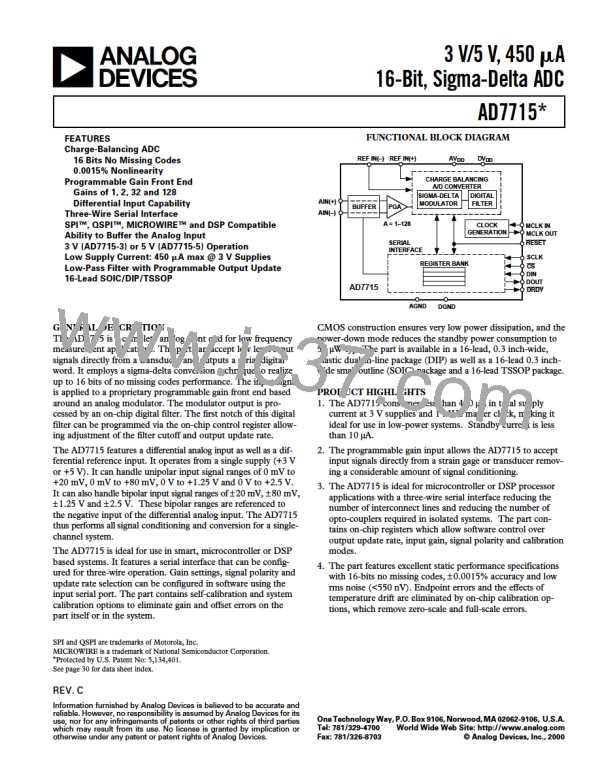AD7715
with a gain of 2 and a VREF of +2.5 V, the input voltage range
on the AIN(+) input is +2.5 V to +3.75 V. If AIN(–) is +2.5 V
and the AD7715 is configured for bipolar mode with a gain of 2
and a VREF of +2.5 V, the analog input range on the AIN(+)
input is +1.25 V to +3.75 V (i.e., 2.5 V ± 1.25 V). If AIN(–) is
at AGND, the part cannot be configured for bipolar ranges in
excess of ±30 mV.
DIGITAL FILTERING
The AD7715 contains an on-chip low-pass digital filter that
processes the output of the part’s sigma-delta modulator. There-
fore, the part not only provides the analog-to-digital conversion
function but it also provides a level of filtering. There are a
number of system differences when the filtering function is
provided in the digital domain rather than the analog domain
and the user should be aware of these.
Bipolar or unipolar options are chosen by programming the B/U
bit of the Setup Register. This programs the channel for either
unipolar or bipolar operation. Programming the channel for
either unipolar or bipolar operation does not change any of the
input signal conditioning; it simply changes the data output
coding and the points on the transfer function where calibra-
tions occur.
First, since digital filtering occurs after the A-to-D conversion
process, it can remove noise injected during the conversion
process. Analog filtering cannot do this. Also, the digital filter
can be made programmable far more readily than an analog
filter. Depending on the digital filter design, this gives the user
the capability of programming cutoff frequency and output
update rate.
REFERENCE INPUT
On the other hand, analog filtering can remove noise superim-
posed on the analog signal before it reaches the ADC. Digital
filtering cannot do this and noise peaks riding on signals near
full scale have the potential to saturate the analog modulator
and digital filter, even though the average value of the signal is
within limits. To alleviate this problem, the AD7715 has over-
range headroom built into the sigma-delta modulator and digital
filter which allows overrange excursions of 5% above the analog
input range. If noise signals are larger than this, consideration
should be given to analog input filtering, or to reducing the
input channel voltage so that its full scale is half that of the
analog input channel full scale. This will provide an overrange
capability greater than 100% at the expense of reducing the
dynamic range by 1 bit (50%).
The AD7715’s reference inputs, REF IN(+) and REF IN(–),
provide a differential reference input capability. The common-
mode range for these differential inputs is from AGND to
AVDD. The nominal reference voltage, VREF (REF IN(+) –
REF IN(–)), for specified operation is +2.5 V for the AD7715-5
and +1.25 V for the AD7715-3. The part is functional with
VREF voltages down to 1 V but with degraded performance as
the output noise will, in terms of LSB size, be larger. REF IN(+)
must always be greater than REF IN(–) for correct operation of
the AD7715.
Both reference inputs provide a high impedance, dynamic load
similar to the analog inputs in unbuffered mode. The maximum
dc input leakage current is ±1 nA over temperature and source
resistance may result in gain errors on the part. In this case, the
sampling switch resistance is 5 kΩ typ and the reference capaci-
tor (CREF) varies with gain. The sample rate on the reference
inputs is fCLK IN/64 and does not vary with gain. For gains of 1
and 2, CREF is 8 pF; for a gain of 32, it is 4.25 pF, and for a gain
of 128, it is 3.3125 pF.
In addition, the digital filter does not provide any rejection at
integer multiples of the digital filter’s sample frequency. How-
ever, the input sampling on the part provides attenuation at
multiples of the digital filter’s sampling frequency so that the
unattenu-ated bands actually occur around multiples of the
sampling frequency fS (as defined in Table XV). Thus the unat-
tenuated bands occur at n × fS (where n = 1, 2, 3. . . ). At these
frequencies, there are frequency bands, ±f3 dB wide (f3 dB is the
cutoff frequency of the digital filter) at either side where noise
passes unattenuated to the output.
The output noise performance outlined in Tables V through XII
is for an analog input of 0 V which effectively removes the effect
of noise on the reference. To obtain the same noise performance
as shown in the noise tables over the full input range requires a
low noise reference source for the AD7715. If the reference
noise in the bandwidth of interest is excessive, it will degrade
the performance of the AD7715. In applications where the
excitation voltage for the bridge transducer on the analog input
also derives the reference voltage for the part, the effect of the
noise in the excitation voltage will be removed as the application
is ratiometric. Recommended reference voltage sources for the
AD7715-5 include the AD780, REF43 and REF192, while the
recommended reference sources for the AD7715-3 include the
AD589 and AD1580. It is generally recommended to decouple
the output of these references in order to further reduce the
noise level.
Filter Characteristics
The AD7715’s digital filter is a low-pass filter with a (sinx/x)3
response (also called sinc3). The transfer function for this filter
is described in the z-domain by:
3
−N
1
1–
z
H(z)=
×
1– z–1
N
and in the frequency domain by:
3
f
fs
in
S
×π×
N
1
|H( f )|=
×
N
f
fs
Sin π×
where N is the ratio of the modulator rate to the output rate and
fMOD is the modulator rate.
REV. C
–16–

 ADI [ ADI ]
ADI [ ADI ]